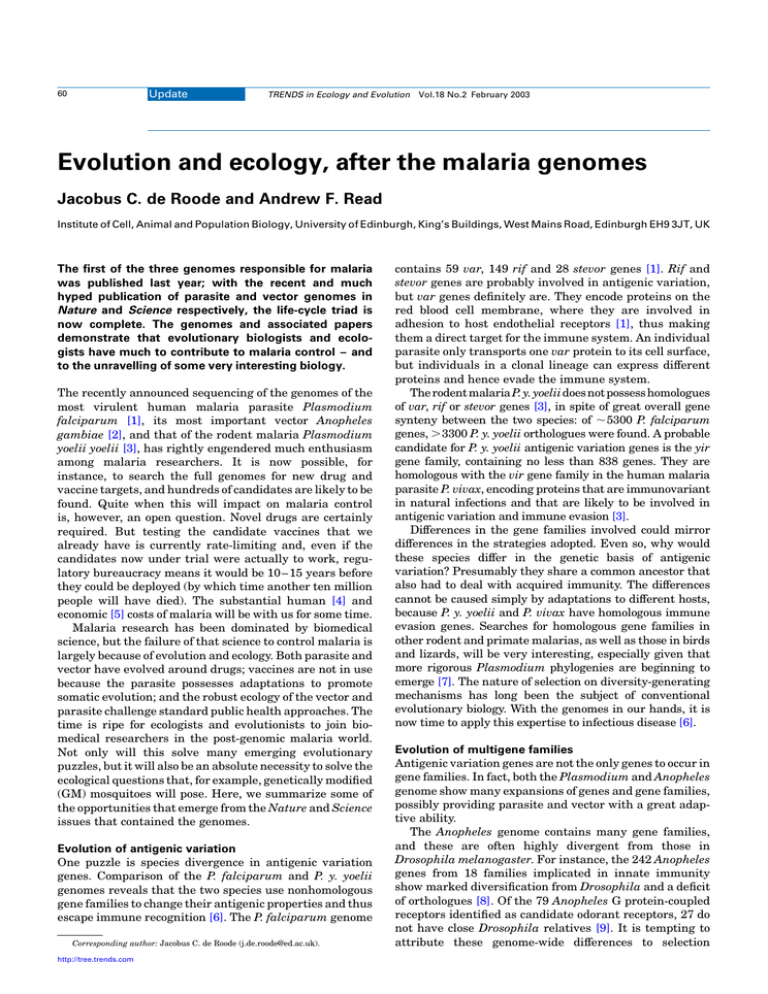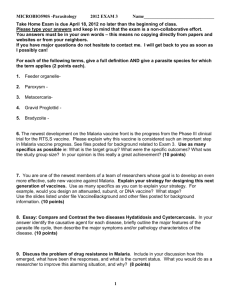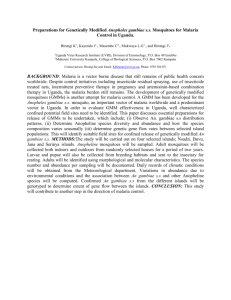
Update
60
TRENDS in Ecology and Evolution
Vol.18 No.2 February 2003
Evolution and ecology, after the malaria genomes
Jacobus C. de Roode and Andrew F. Read
Institute of Cell, Animal and Population Biology, University of Edinburgh, King’s Buildings, West Mains Road, Edinburgh EH9 3JT, UK
The first of the three genomes responsible for malaria
was published last year; with the recent and much
hyped publication of parasite and vector genomes in
Nature and Science respectively, the life-cycle triad is
now complete. The genomes and associated papers
demonstrate that evolutionary biologists and ecologists have much to contribute to malaria control – and
to the unravelling of some very interesting biology.
The recently announced sequencing of the genomes of the
most virulent human malaria parasite Plasmodium
falciparum [1], its most important vector Anopheles
gambiae [2], and that of the rodent malaria Plasmodium
yoelii yoelii [3], has rightly engendered much enthusiasm
among malaria researchers. It is now possible, for
instance, to search the full genomes for new drug and
vaccine targets, and hundreds of candidates are likely to be
found. Quite when this will impact on malaria control
is, however, an open question. Novel drugs are certainly
required. But testing the candidate vaccines that we
already have is currently rate-limiting and, even if the
candidates now under trial were actually to work, regulatory bureaucracy means it would be 10 – 15 years before
they could be deployed (by which time another ten million
people will have died). The substantial human [4] and
economic [5] costs of malaria will be with us for some time.
Malaria research has been dominated by biomedical
science, but the failure of that science to control malaria is
largely because of evolution and ecology. Both parasite and
vector have evolved around drugs; vaccines are not in use
because the parasite possesses adaptations to promote
somatic evolution; and the robust ecology of the vector and
parasite challenge standard public health approaches. The
time is ripe for ecologists and evolutionists to join biomedical researchers in the post-genomic malaria world.
Not only will this solve many emerging evolutionary
puzzles, but it will also be an absolute necessity to solve the
ecological questions that, for example, genetically modified
(GM) mosquitoes will pose. Here, we summarize some of
the opportunities that emerge from the Nature and Science
issues that contained the genomes.
Evolution of antigenic variation
One puzzle is species divergence in antigenic variation
genes. Comparison of the P. falciparum and P. y. yoelii
genomes reveals that the two species use nonhomologous
gene families to change their antigenic properties and thus
escape immune recognition [6]. The P. falciparum genome
Corresponding author: Jacobus C. de Roode (j.de.roode@ed.ac.uk).
http://tree.trends.com
contains 59 var, 149 rif and 28 stevor genes [1]. Rif and
stevor genes are probably involved in antigenic variation,
but var genes definitely are. They encode proteins on the
red blood cell membrane, where they are involved in
adhesion to host endothelial receptors [1], thus making
them a direct target for the immune system. An individual
parasite only transports one var protein to its cell surface,
but individuals in a clonal lineage can express different
proteins and hence evade the immune system.
The rodent malaria P. y. yoelii does not possess homologues
of var, rif or stevor genes [3], in spite of great overall gene
synteny between the two species: of ,5300 P. falciparum
genes, .3300 P. y. yoelii orthologues were found. A probable
candidate for P. y. yoelii antigenic variation genes is the yir
gene family, containing no less than 838 genes. They are
homologous with the vir gene family in the human malaria
parasite P. vivax, encoding proteins that are immunovariant
in natural infections and that are likely to be involved in
antigenic variation and immune evasion [3].
Differences in the gene families involved could mirror
differences in the strategies adopted. Even so, why would
these species differ in the genetic basis of antigenic
variation? Presumably they share a common ancestor that
also had to deal with acquired immunity. The differences
cannot be caused simply by adaptations to different hosts,
because P. y. yoelii and P. vivax have homologous immune
evasion genes. Searches for homologous gene families in
other rodent and primate malarias, as well as those in birds
and lizards, will be very interesting, especially given that
more rigorous Plasmodium phylogenies are beginning to
emerge [7]. The nature of selection on diversity-generating
mechanisms has long been the subject of conventional
evolutionary biology. With the genomes in our hands, it is
now time to apply this expertise to infectious disease [6].
Evolution of multigene families
Antigenic variation genes are not the only genes to occur in
gene families. In fact, both the Plasmodium and Anopheles
genome show many expansions of genes and gene families,
possibly providing parasite and vector with a great adaptive ability.
The Anopheles genome contains many gene families,
and these are often highly divergent from those in
Drosophila melanogaster. For instance, the 242 Anopheles
genes from 18 families implicated in innate immunity
show marked diversification from Drosophila and a deficit
of orthologues [8]. Of the 79 Anopheles G protein-coupled
receptors identified as candidate odorant receptors, 27 do
not have close Drosophila relatives [9]. It is tempting to
attribute these genome-wide differences to selection
Update
TRENDS in Ecology and Evolution
pressures from different food sources. But why should
detecting rotting fruit or humans require radically different
genetic control? And why should the fruit- and blood-borne
pathogens require such different immune control? Has gene
proliferation been a cause or a consequence of the adaptive
plasticity that has the malaria parasite and its vector
resilient in the face of 100 years of medical onslaught?
Vector behaviour and physiology
Malaria parasites decrease vector fecundity [10] and
increase biting rate and blood-meal size [11]. These alterations could be adaptive for the parasite (e.g. reallocation from
reproduction to parasite nutrition) or host (reallocation from
reproduction to immune function), or adaptive for neither.
Differentiating between these alternatives can be done by
measuring the fitness consequences of the altered phenotypes for the players involved, but it is not always easy to
manipulate these experimentally. A different approach is to
determine which genes are running the show.
Holt et al. [2] present a study of blood-meal-fed and
nonblood-meal-fed mosquitoes, and show that genes
involved in egg melanisation and yolk and oocyte production were upregulated in blood-fed mosquitoes. A next
step is to compare gene expression patterns of mosquitoes
fed infected or uninfected blood. Alternatively, are there
Anopheles-like genes in the malaria genome? These might
be good candidates as host-manipulation genes.
One candidate gene involved in the decreased fecundity
is one of 35 putative regulatory genes [12]. This gene is
closely related to an Aedes aegypti homologue that is
expressed in ovaries only during reproductive arrest and
the first 24 hr of a reproductive cycle when ecdysteroids
are being synthesized. This receptor is possibly involved in
hormonal regulation and physiological pathways that, in
D. melanogaster and Caenorhabditis elegans, are involved
in the link between longevity and fecundity. If this is the
key regulatory switch between arrest/longevity and reproduction in An. gambiae, it could be the target mechanism
of any adaptive manipulation of the reproductive physiology of the mosquito by the parasite.
Ecological challenges of GM mosquitoes
In the past, malaria control has been achieved mainly by
mosquito control [13]. With the increasing problems of
insecticide resistance, many malaria researchers now
focus their hopes on changing the genetic makeup of the
mosquito to block transmission or to decrease mosquito
fitness. The genomes will provide many candidate genes to
accomplish this. Rapidly advancing technology has
already made it possible to create transgenic mosquitoes
that do not transmit malaria [14]. Indeed, we are now at a
stage at which the technological challenges of manipulating genes in vivo are trivial compared to the ecological
challenges of using this technology to control malaria [15].
There is room for a lot more thinking about which genes
should be used and then how they should be driven into wild
populations [15]. This is an area that has already seen
significant contributions from evolutionary biologists [16].
But much more is needed, particularly to fill out our
incomplete understanding of parasite transmission ecology
[17]. For example, we need to know more about gene flow
http://tree.trends.com
Vol.18 No.2 February 2003
61
within and between mosquito populations. What are the
fitness consequences of genetic modification of mosquitoes?
And what counter evolution by the parasite will GM
mosquitoes prompt? Scott et al. [17] argue that continued
evaluation of GM technology will require release of GM
mosquitoes on isolated oceanic or ecological islands that have
been thoroughly characterized with respect to the genetic
and ecological makeup of local mosquito vector populations
and site-specific patterns of pathogen transmission and
disease. That is a lot of untrendy ‘muddy boots’ ecology.
Outlook
Clearly, the molecular biologists who make GM mosquitoes
will need ecologists to tackle these complicated ecological
problems. In a time of increasingly big science, even the early
findings from the post-genomic era show that readers of
TREE will be as needed in malaria research as are readers of
Trends in Genetics, Parasitology or Microbiology. Indeed, in
an academic world where we know an enormous amount
about banana-dwelling flies, one could argue that a focus by
evolutionary biologists and ecologists on an organism that is
at least as interesting as a fruit fly is long overdue. Research
funding opportunities are arguably the only benefit of the
catastrophic death toll from malaria.
References
1 Gardner, M.J. et al. (2002) Genome sequence of the human malaria
parasite Plasmodium falciparum. Nature 419, 498 – 511
2 Holt, R.A. et al. (2002) The genome sequence of the malaria mosquito
Anopheles gambiae. Science 298, 129 – 149
3 Carlton, J.M. et al. (2002) Genome sequence and comparative analysis
of the model rodent malaria parasite Plasmodium yoelii yoelii. Nature
419, 512 – 519
4 Breman, J.G. (2001) The ears of the hippopotamus: manifestations,
determinants, and estimates of the malaria burden. Am. J. Trop. Med.
Hyg. 64, 1 – 11
5 Sachs, J. and Malaney, P. (2002) The economic and social burden of
malaria. Nature 415, 680– 685
6 Frank, S.A. (2002) Immunology and Evolution of Infectious Disease,
Princeton University Press
7 Perkins, S.L. and Schall, J.J. (2002) A molecular phylogeny of malarial
parasites recovered from cytochrome b gene sequences. J. Parasitol.
88, 972 – 978
8 Christophides, G.K. et al. (2002) Immunity-related genes and gene
families in Anopheles gambiae. Science 298, 159 – 165
9 Hill, C.A. et al. (2002) G protein coupled receptors in Anopheles
gambiae. Science 298, 176 – 178
10 Hurd, H. et al. (1995) Interactions between bloodfeeding, fecundity and
infection in mosquitos. Parasitol. Today 11, 411 – 416
11 Koella, J.C. (1999) An evolutionary view of the interactions between
anopheline mosquitoes and malaria parasites. Microbes Infect. 1,
303 – 308
12 Riehle, M.A. et al. (2002) Neuropeptides and peptide hormones in
Anopheles gambiae. Science 298, 172– 175
13 Spielman, A. and D’Antonio, M. (2001) Mosquito. A Natural History of
our most Persistent and Deadly Foe, Faber and Faber
14 Ito, J. et al. (2002) Transgenic anopheline mosquitoes impaired in
transmission of a malaria parasite. Nature 417, 452 – 455
15 Alphey, L. et al. (2002) Malaria control with genetically manipulated
insect vectors. Science 298, 119– 121
16 Turelli, M. and Hoffmann, A.A. (1999) Microbe-induced cytoplasmic
incompatibility as a mechanism for introducing transgenes into
arthropod populations. Insect Mol. Biol. 8, 243– 255
17 Scott, T.W. et al. (2002) The ecology of genetically modified mosquitoes.
Science 298, 117 – 119
0169-5347/02/$ - see front matter q 2002 Elsevier Science Ltd. All rights reserved.
PII: S0169-5347(02)00058-7







